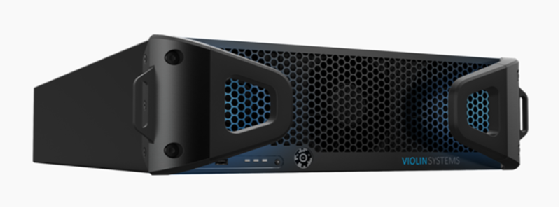Violin Systems AFA lineup adds XVS8 power hitter
Violin, an 'emerging company that's been around a while,' adds new all-flash system that will support NVMe over Fabrics next year and promises extreme performance.
Violin Systems this week unveiled a all-flash flagship, the hardware product launched since its rescue from bankruptcy 18 months ago.
The Violin XVS8 is an NVMe-over-Fabrics-equipped array for scale-up databases, and it pushes the vendor farther from mainstream enterprise competitors. The 3U form factor scales effective capacity from 256 TB to 512 TB for workloads that need extreme performance. Using the Violin Concerto operating systems, customers can apply Violin's inline deduplication to individual applications or LUNs.
The array extends nonvolatile express (NVMe) flash to 32 Gbps Fibre Channel with a SCSI host connection. Violin said customers will be able to add end-to-end NVMe functionality with a software upgrade in 2019.
The XVS arrays mark the introduction of Violin Systems' predictive analytics for storage. The arrays stream telemetry data to Violin's cloud system using the Symphony flash management console. Admins can use an augmented-reality application to get a status update by pointing their smartphone at a QR code on the box.
Violin Systems pledged to continue providing technical support to customers with its Flash Storage Platform arrays while phasing out those systems.
It has been a long road back for Violin Systems, which launched in 2011 and rode early all-flash momentum to become a publicly traded company. Despite more than 60 patents, Violin stumbled when it failed to deliver an integrated software stack. The company filed for bankruptcy in 2017 after failing to find a buyer. The vendor changed its name from Violin to Violin Systems after receiving financing from a private hedge fund last year.
Violin added advanced data services incrementally to its Concerto operating system, including asynchronous and synchronous replication, clustering and thin provisioning. CEO Mark Lewis said Violin still has more than 100 of its original customers.
"We're like an emerging company, but one that's been around a while. We believe in being able to deliver extreme high performance for tier-zero applications," Lewis said.

Expanding on PCIe flash
Violin's nonvolatile dual inline modules incorporate raw NAND flash. The storage controller is housed in a field programmable gate array. The design is intended to enable granular control at the chip level.
Violin XVS8 storage targets applications with extreme performance. XVS8 arrays rate latency in the 100 to 800 microsecond range, Lewis said. Customers can get latency at the low end of that range before data deduplication, he said.
"Right now, NVMe devices are too slow for our storage," Lewis said. "They don't have the software hooks we need. We're working with suppliers to add in APIs in the NVMe stack to let us have that additional software control."
Violin will NVMe SSDs into XVS8 in the quarter of 2019, he added.
"Violin is still focused on the traditional high-end database market and potentially VDI. I think [Violin XVS8] will attract more of the performance-bound AI, deep learning and machine learning workloads," said George Crump, an analyst at Storage Switzerland.
IDC analyst Eric Burgener said the Violin Systems array competes with rack-scale arrays from NVMe-based startups.
"Violin is looking to upgrade to NVMe technology, but it will be based around commodity hardware, not the custom hardware they use today," Burgener said. "One of the things that differentiates Violin from the other guys is that they have a full complement of data services.
XVS8 will definitely affect applications that need NVMe performance, extending all the way to the application layer, Burgener said. "Violin's not completely there yet, since they still only have a SCSI host connection. You'll start getting sub-microsecond latencies when you can upgrade to NVMe over Fabrics," he said.





